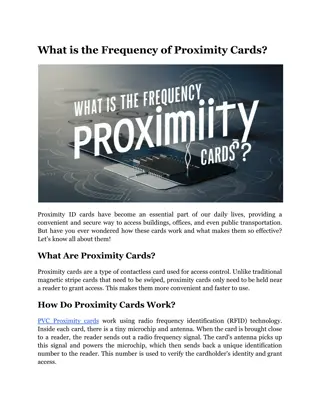
How are Proximity Smart Cards Used in Public Transportation Systems_
Discover how proximity smart cards enhance public transportation systems, making travel easier and more efficient for everyone.n
Download Presentation

Please find below an Image/Link to download the presentation.
The content on the website is provided AS IS for your information and personal use only. It may not be sold, licensed, or shared on other websites without obtaining consent from the author. Download presentation by click this link. If you encounter any issues during the download, it is possible that the publisher has removed the file from their server.
E N D
Presentation Transcript
How Are Proximity Smart Cards Used in Public Transportation Systems? Public transportation is undergoing a massive transformation, and at the heart of this change are proximity smart cards. These smart cards allow commuters to enjoy streamlined access to transit systems, faster boarding, and a more secure payment method, making them a vital part of modern urban mobility. Whether on a bus, metro, train, or tram, proximity cards offer convenience for passengers while helping transit authorities manage crowds and increase efficiency. Understanding Prox Cards Proximity cards are embedded with microchips and antennae that enable contactless communication with card readers. These cards operate on RFID (Radio Frequency Identification) or NFC (Near Field Communication) technology, allowing users to simply tap or wave their card near a reader to gain entry to a transit system. Unlike traditional magnetic stripe cards or paper tickets, prox cards are durable, reusable, and can store a wide range of data, from prepaid balance to personal identification information.
Key Features of Proximity Cards in Public Transit Prox cards used in public transportation have specific features designed to streamline the commuting experience: Contactless Access: With no need to swipe or insert the card, commuters can move quickly through entry gates. Automatic Fare Calculation: These cards can calculate fares automatically based on distance, time, or type of service. Account Linkage: Cards can link to an online account where users add funds or view travel history. Durability: Unlike paper tickets, smart cards can last several years, even under heavy daily use. How Prox Cards Work in Transit Systems When passengers use a proximity card to access a bus or train, they re engaging with a complex technology that operates in the background to simplify their journey. Here s how it works: 1. Card Activation: Upon issuance, the card is activated and linked to a transit account, allowing funds to be added or deducted automatically. 2. Authentication at Gates: The cardholder taps the card on a reader, and RFID technology quickly verifies the card's validity and balance. 3. Data Exchange: The card communicates with the transit system to store details like entry time and location, helping calculate the fare. 4. Balance Deduction: Upon exit or at the end of the journey, the fare is deducted from the card balance. 5. Usage Data Collection: Transit authorities collect data to analyze commuter patterns and optimize services. These steps may occur within seconds, ensuring that thousands of people can move through stations quickly and efficiently. Benefits of Proximity Smart in Public Transit Prox cards provide numerous benefits for commuters and transportation authorities alike. Here s a breakdown:
Benefit Advantages Commuters for Advantages Authorities for Transit Speed Convenience and Faster reduced queuing boarding times, Shorter capacity wait times, increased Contactless Payment Simple tap-to-pay function Reduced ticket sales cash handling, fewer Account Management Users monitor cards online can recharge and Real-time fare adjustment reduced ticket maintenance Security Durability and Long-lasting, counterfeit difficult to Enhanced system security, fewer lost or damaged tickets Data Analytics Insights into peak travel times and route popularity These benefits make proximity smart card a win-win for both passengers and transportation authorities. Types of Proximity Cards Used in Transit There are various types of proximity cards available, each suited to different uses and technologies. Public transportation systems often use one or more of the following card types: Standard Prox Cards: Basic RFID-enabled cards that allow for quick, contactless access. HID Card II: Known for robust security features, HID Prox Card II models are often used in settings where added access control is required. Multi-Application Smart Cards: These cards can serve dual purposes, such as providing both transit access and building entry. Rechargeable Cards: Often linked to an online account, these cards allow passengers to add funds as needed. The type of card chosen depends on the needs of the transit system and the features it wishes to provide.
Choosing the Right Smart Card Vendors Selecting the right proximity card vendors is essential for ensuring quality, durability, and system compatibility. Vendors who specialize in public transit solutions offer customized options that are designed to integrate smoothly with a city s existing transit infrastructure. When evaluating vendors, here are some key factors to consider: Compatibility with Existing Systems: Look for vendors that offer cards compatible with existing hardware and software. Durability Standards: Cards used in public transit must withstand daily wear and tear, so choosing a vendor with high-quality, tested materials is crucial. Data Security Features: Leading vendors provide encryption and other security features to protect both commuter data and transit authority systems. Environmental Impact: Consider vendors who offer eco-friendly materials, as millions of cards are produced for transit systems globally each year. Key Challenges in Using Prox Cards in Public Transit Despite the many advantages, smart cards also present a few challenges for transit authorities and users: Initial Setup Cost: Implementing smart card systems can be costly, requiring new hardware, software, and infrastructure. Card Replacement and Maintenance: Although durable, cards can still be lost, stolen, or damaged, leading to replacement and administrative costs. System Downtime Risks: If the card readers malfunction or the system goes offline, it can disrupt entire transit networks. User Adoption: Some riders, especially those unfamiliar with technology, may need additional support and education to use smart cards effectively. Addressing these challenges requires proper planning, robust vendor support, and regular maintenance. Comparing Proximity Cards to Other Access Methods It s worth noting that smart cards are not the only solution for transit access. Here s a comparison with other popular methods: Access Method Description Pros Cons
Proximity Card Contactless card with RFID/NFC technology Fast, versatile secure, Initial risk of loss setup costs, Magnetic Stripe Card Swiped magnetic stripe card with Familiar to users Prone slower processing to damage, Mobile App or Digital Wallet App-based NFC-enabled devices or Convenient, eliminates physical card Depending phone network needed on the the mobile battery, QR Code Ticket Scannable single-trip access code for Low-cost, easy for single-use Requires smartphone, not durable Each method has unique strengths, but proximity cards strike a balance between speed, durability, and security, making them a top choice for many large-scale transit systems. How Prox Cards Benefit Future Transit Innovation As urban populations grow and transit demands increase, proxy cards are playing a crucial role in enabling future transit innovations: Seamless interoperability, allowing users to transfer easily between buses, trains, bikes, and even ride-share services. Personalized Travel Data: Transit systems can use smart card data to offer personalized services, such as suggesting alternative routes or sending fare alerts. Smart City Integration: Proximity cards can sync with broader smart city initiatives, like monitoring foot traffic or integrating with citywide environmental data. Upgradable Technology: Proxy technologies, such as mobile app integration and biometric security. Multi-Modal Integration: Proximity cards can support cards are compatible with emerging These capabilities position smart cards as a scalable and adaptable choice for evolving transit networks. Conclusion Prox smart cards have transformed public transportation, offering an efficient, secure, and durable solution that benefits both commuters and transit operators. For transit authorities, smart cards provide a wealth of data to improve service planning and create
a better user experience overall. Public transportation is ready to meet the demands of a modern, connected city with HID access control cards. Ready to bring efficiency and security to your transit system? Contact Bristol ID Technologies today to explore smart card solutions that fit your system s unique needs. Site Article: How are Proximity Smart Cards Used in Public Transportation Systems?






















